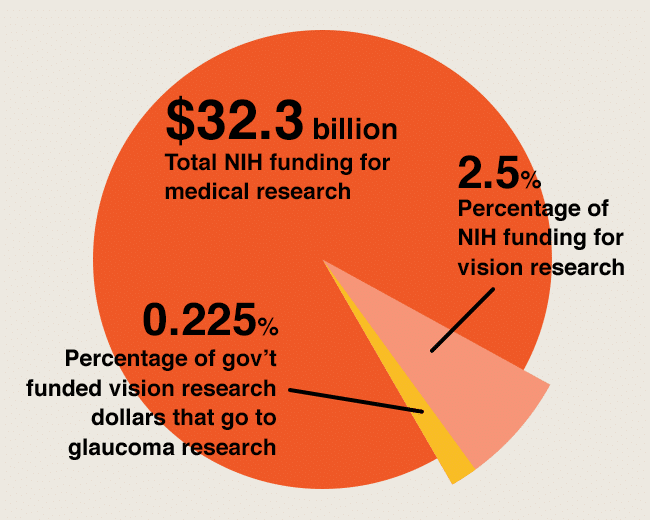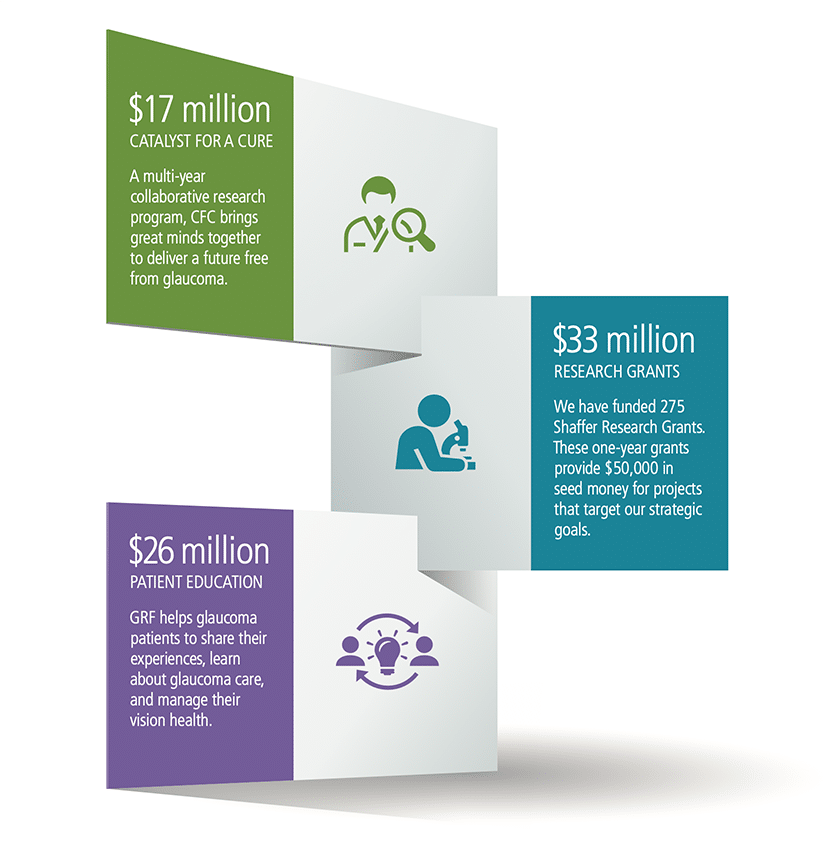The Path To A Cure for Glaucoma
Every day, glaucoma researchers work to better understand and find safer, more effective ways to treat this debilitating disease.

Researchers are hard at work developing treatments that range from better diagnostic equipment and longer-lasting medications to nerve regeneration and stem cell rejuvenation. It’s a lot of work, and is constantly evolving as our understanding of glaucoma improves. Someday, a cure will be discovered that will eliminate or even reverse vision loss caused by glaucoma. In the meantime, Glaucoma Research Foundation is dedicated to finding new treatments and improving patient options.
Current Treatment Options
Glaucoma treatment currently falls within three basic categories: medication, incisional surgery, and laser treatments. All of these are aimed at lowering intraocular pressure (IOP) within the eye. While these are effective for most patients, many continue to lose vision through damage to the optic nerve. For them, there is great need for treatments that stop progression independent of IOP.
Eyedrops are the standard medication option for glaucoma patients. They lower fluid pressure by stimulating the eye’s own drainage system or by decreasing the eye’s fluid production.
Laser light is used to open drainage channels in the eye.
Open-angle glaucoma laser treatments include:
- Selective laser trabeculopalsty (SLT)
- Argon Laser trabeculoplasty (ALT)
- Trans-scleral photocoagulation
Closed-angle glaucoma laser treatments include:
- Laser iridotomy
- Peripheral iridoplasty
Surgery is used to either open the natural drainage channels in the eye, to insert tiny shunts to improve drainage, or to remove that part of the eye that is preventing fluid drainage. There are two primary kinds of non-laser surgery:
- Trabeculectomy is the most common kind of surgery, and creates a controlled leak of fluid from the eye.
- Goniotomy is a surgical option for babies and young children with congenital glaucoma, when a special lens is required to see the structure of the inner eye.
These three treatment options—eyedrops, surgeries, and laser therapy—are generally very effective. However, there are drawbacks. Surgery, while only utilized by approximately 11% of glaucoma patients, is intimidating and can cause complications or infections. Medications like eyedrops can expose patients to potential side effects, and efficacy is reduced if patients fail to take the medication consistently.
Promising New Research
Researchers around the world are making great strides toward more effective treatment options that may one day lead to a cure. Here are a few of the top research programs where we are seeing results:
There are improvements in the medication arena such as drug-dispensing contact lenses and micro-pumps that would eliminate the need for daily eyedrops.
Meanwhile, genetic and cellular regeneration therapies are being experimented with, in the hopes that they will one day lead to preventing or reversing damage to optic nerve tissue.
There is strong evidence that cataract surgery can effectively cure closed-angle glaucoma.
Also, new stents have come to market that can be inserted in the ophthalmologist’s office with a syringe, completely avoiding surgery.
In addition to drug dispensing contact lenses, there are also pressure-monitoring contacts, implantable medicine pumps, eye-glasses that increase the wearer’s field of vision, and technology that sends visual signals directly to the brain.
Challenges Faced by Researchers
Government funding for scientific research may be plentiful, and clinically-promising treatments are brought to market thanks to venture capitalists. But funding that moves high-risk, high reward experiments—ones that could lead to innovative new treatments or even a cure for glaucoma—out of the lab and into the clinic, is scarce.
Researchers often see their promising new therapies halted early in the pipeline, making it impossible for them to ever successfully apply for FDA approval, or bring their revolutionary concepts to market in order to help glaucoma patients. Additionally, researchers may feel pressured to alter their design, methodology, or area of research to maintain government funding.
According to their website, the NIH invests nearly $32.3 billion annually in medical research. $815 million is earmarked for eye health and vision-related disease. That money goes to:

What We Do
Glaucoma Research Foundation is dedicated to finding a cure for glaucoma, having invested $50 million in glaucoma research programs, including over 275 one-year grants. This GRF-funded research has led to more than 200 publications.

GRF has also worked to speed up the pace of discovery by creating a unique collaborative research program called Catalyst for a Cure, which has helped define glaucoma as a neurodegenerative disease, shifted the focus of research to protecting retinal nerve cells, and identified new biomarkers to indicate the earliest signs of glaucoma and help guide treatment to preserve vision.
What Can You Do To Help?
To be able to support cutting edge glaucoma research, GRF needs your support. Donate today!
Everything you do to support GRF’s mission, whether through donations, volunteer work, spreading the word, or lobbying your state and federal representatives, supports the researchers who are working to end glaucoma, which makes you part of this journey towards a cure.
Reviewed on April 19, 2022.